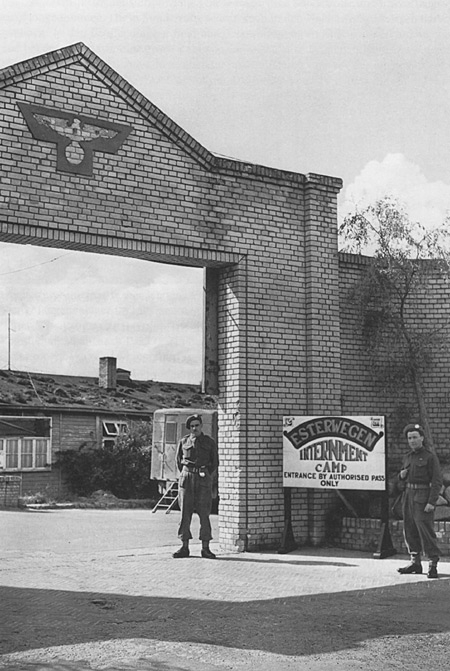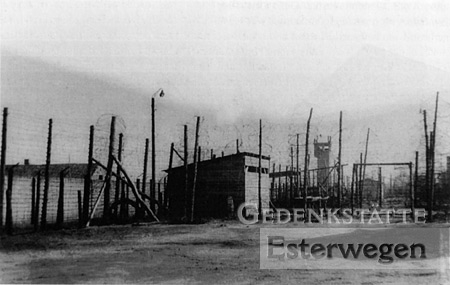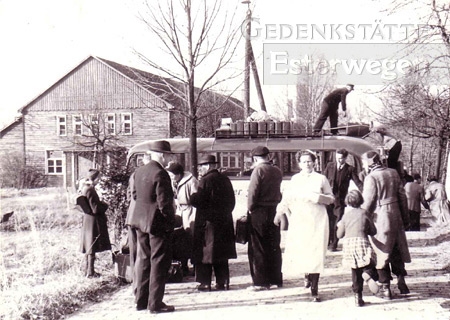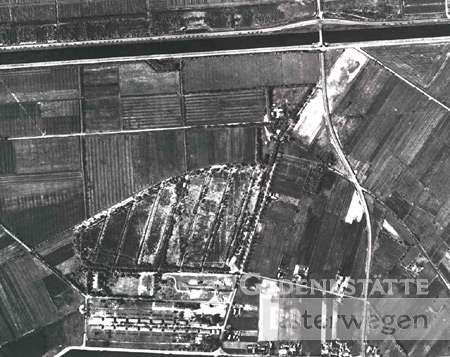Camp Esterwegen
Post-war use after 1945
1945-1947
In the summer of 1945, the British occupation authorities set up nine internment camps in northern Germany, utilizing former German camps as accommodation. For a short time, Esterwegen was called “No. 9 CIC (Civil Internment Camp)” and was then renamed “No. 101 CIC”. The camp was guarded by Canadian troops.
Soon after the end of hostilities, Nazi functionaries from the region and members of the Wehrmacht were interned here by the British authorities. These included a small number of women. So-called “suspect persons” were also admitted. These were people who were detained without any specific reason as a purely precautionary measure. The aim of this measure was to ensure the safety of the occupying troops. Another larger group consisted of members of the German security personnel from the formerly occupied Netherlands and Norway, including many members of the 27th SS Police Regiment from Norway.
From January 1946, almost exclusively alleged war criminals were brought to Esterwegen, while the other internees and “suspect persons” were released or distributed to other camps. The alleged war criminals were primarily former SS guards from the concentration camps. The majority were of German nationality, but there were also around 550 “ethnic German” SS members from Romania, Hungary, Poland, the CSR and Yugoslavia. The British authorities also interned a small number of German, Polish, Russian and French functionary prisoners of Jewish and non-Jewish origin, including those from the Sandbostel and Bergen-Belsen camps.
The inmates also included members of the Litzmannstadt ghetto administration and the Reich Main Security Office, SS doctors and the commandants of the Cholm and Dachau concentration camps (Johannes Beike and Alexander Piorkowski). The former commander-in-chief of the Emsland prison camps, Werner Schäfer, was also imprisoned in Esterwegen for a month in 1946 before being relocated to Great Britain.
In this way, the internees were initially to be concentrated in Esterwegen so that they could later be transferred to the respective courts. Subsequently, they were extradited to the USSR, Yugoslavia and, in individual cases, to France. Other people were to be held as witnesses in war crimes trials.
Esterwegen reached its peak occupancy in June 1946 with 2,547 internees.
1947-1951
In July 1947, the British occupying authorities set up so-called “trial courts” in their zone to prosecute people who had belonged to organizations that had been classified as criminal in the main war crimes trial at Nuremberg (Gestapo, SS, SD). The courts could impose prison sentences and Esterwegen was designated as the place of detention. For this reason, the suspected war criminals still remaining there were taken to the newly established “War Criminals Holding Center” in Hamburg-Fischbek or to other internment camps.
At the same time, Esterwegen was used as a regular prison by the German justice administration starting in summer 1947. Strictly separated from the other prisoners, around 900 convicts were held under British supervision. Among them were the former Gauleiter Franz Schwede, Friedrich Karl Florian, Paul Wegener and Hinrich Lohse. They also included the senior SS leaders Udo von Woyrsch and Emil Mazuw, the commandant of the Gross-Rosen concentration camp Wilhelm Gideon and the officials of the former Reich Security Main Office Otto Hunsche and Franz Sonderegger.
However, the number of prisoners sentenced by the trial court steadily decreased due to releases and pardons, so that Esterwegen was closed as a prison for those sentenced by the trial court as early as 1951.
1959-1961
Return of the camp site to the state of Lower Saxony. Used as a residential camp for judicial staff.
1963-2001
Handover of the camp site to the Federal Republic of Germany. Used as a Bundeswehr depot, first for clothing, then for rations, and finally for a reserve military hospital group. All remaining barracks were demolished, warehouses were built on both sides of the camp road and green strips were laid out. 2001 Acquisition by the Emsland district.
From 2006
- May 2006: Opening of the temporary operation of the Esterwegen Memorial.
- August 2008: The Esterwegen Memorial Foundation takes over the site of the former Esterwegen concentration and prison camp from the Emsland district.
- Spring and fall 2009: Start of the first measures to establish a memorial site
- October 31, 2011: Opening of the Esterwegen Memorial
Short guided tours:
Every 1st Sunday of the month, at 11am and 3pm. Please contact us in advance for a tour in English.









